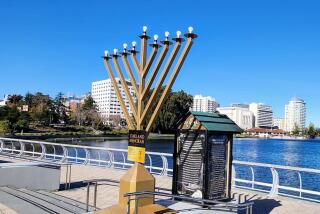People of the Book : Students Help to Revive the Judaic Tradition of Burying Sacred Texts
- Share via
Each bearing a worn religious book no longer usable, about 250 Jewish school students Tuesday helped Mt. Sinai Memorial Park revive the Judaic tradition of burying sacred texts--taking their theme from Islam’s Prophet Mohammed.
“We are the people of the book” was an oft-repeated refrain during a 45-minute service written for the occasion after research turned up no record of a Jewish ritual.
The phrase “people of the book” first appeared in the Koran, the 7th Century scriptures of Islam, as a Muslim term of respect for Jews and Christians as believers in the God of the Bible. Despite today’s Mideast political strife, Muslims honor such biblical figures as Abraham, Moses and Jesus while believing that Mohammed was the final messenger of God.
A reverence for sacred writings is common to all three faiths. As far back as the Middle Ages, Jews placed damaged or unused books containing the name of God into synagogue storerooms or buried them next to coffins, rather than burning or discarding them.
Book burials have taken place in modern times as well, but usually without ceremony. Not that every Jewish household observed the tradition, said Rabbi Ben Zion Bergman, a professor at the University of Judaism in the Sepulveda Pass who led Tuesday’s service.
“Many Jews are unaware of the practice or don’t know where to take their books if they do know of the tradition,” said Bergman, a consultant to Mt. Sinai Memorial Park, a cemetery in the southeast corner of the San Fernando Valley.
The cemetery has accepted discarded Jewish books in the past, placing them in a 30-by-30-foot concrete genizah , or hiding place, on the grounds. It sits below a mosaic of the Jewish zodiac--a reproduction five times larger than the original found in a 6th Century synagogue.
Arnold Saltzman, general manager of the cemetery, said he thought a ceremony “recognizing the sacredness of the written word” would be fitting as well as educational for Jewish youth.
Advertising consultant Russ Alben, once an executive with an agency that handled Timex and Mattel toys, was asked to prepare a service, but he was initially stymied.
“In a religion which has compiled an exhausting number of rules, rituals and liturgies dealing with every aspect of our lives, no prayer service for book burials was published,” said Alben, a board director at Westwood’s Sinai Temple, which operates the cemetery.
Assisted by librarians and professors, Alben composed a service, with students of eight Jewish schools in the Los Angeles area taking part.
At the burial site in a tree-shaded area of the cemetery, Josh Clay of Atid Hebrew Academy in Covina recounted a Jewish legend that Israel chose the Torah over the sword at a crucial time in its ancient history. Courtney Field of Heschel Day School in Northridge told of the time in 1933 when Nazis seized books “by Jews named Freud and Einstein and Helen Keller” in a prelude to the Holocaust.
“Who saw the quality that makes us so different from any other people on earth?” said Adrian Engel of Akiba Academy in Westwood, reading her portion of the ritual. “A rabbi? A philosopher? The answer is surprising. . . . Over 1,300 years ago, Mohammed first used this name (the people of the book).”
Midway through the service, children from the schools lined up to hand old prayer books and other works to cemetery workers who placed them in the 10-foot-deep genizah .
Aaron Aghachi, 12, of Azusa got close enough to sniff the dank odor from the hole. “It smelled really bad,” he said.
“Like an attic,” added Michelle Maso, 12, of Covina.
Courtney Field, 11, thought the service was a good idea. “It shows us to respect the books we’ve used and read from,” she said.
Saltzman, the cemetery general manager, added to the genizah a yellowed book whose binding was split. It was a Yiddish translation of the Torah, an edition written especially for women and published in 1874.
“A gentleman gave it to me when he heard about this service,” Saltzman said. “He said his grandparents gave it to him, and all these years he couldn’t bring himself to throw it away.”
More to Read
Sign up for Essential California
The most important California stories and recommendations in your inbox every morning.
You may occasionally receive promotional content from the Los Angeles Times.













